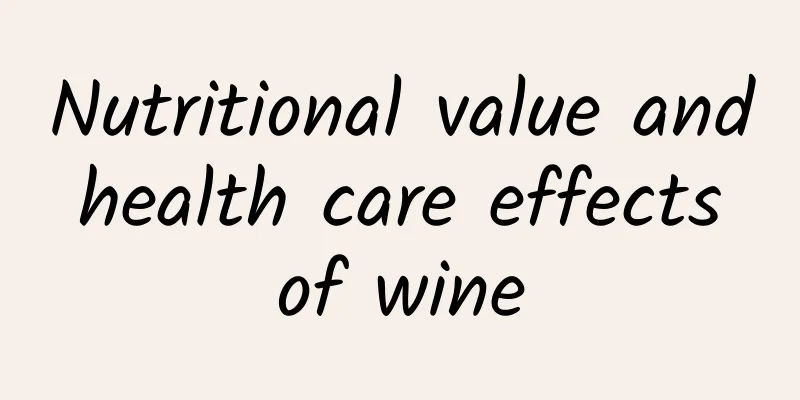Nutritional value and health care effects of wine

|
Wine is a type of wine that is low in alcohol, sugar and calories and rich in amino acids, vitamins and inorganic salts. Most of the nutrients in wine come from grape juice, and the ethanol it contains comes from juice fermentation. Chemical composition of wineWine generally contains about 10% to 16% alcohol, and the ethanol it contains comes from fruit juice fermentation. Its chemical composition comes from grape juice. More than 250 components have been analyzed so far. 1. Various sugars: It contains glucose, fructose, pentose, gum and mucus, all of which are essential sugars for the human body. 2. Organic acids: It contains tartaric acid, malic acid, succinic acid, citric acid, etc., which are substances that maintain the acid-base balance in the body and can help digestion. 3. Inorganic salts: Wine contains potassium oxide and magnesium oxide, and the ratio of potassium and magnesium in wine is exactly the same as the ratio of potassium and magnesium in human muscle. Wine has a high phosphorus content, low calcium, low sodium nitride and aluminum oxide, and contains sulfur, chlorine, iron, silicon dioxide, zinc, copper, selenium, etc. 4. Nitrogen-containing substances: The average nitrogen content in general wine is about 0.05%-0.027%. Wine contains 1 gram/liter of protein and 18 kinds of amino acids. 5. Vitamins and vitamin-like substances: Wine contains thiamine, riboflavin, niacin, vitamin B6, vitamin B12, pantothenic acid, folic acid, biotin, vitamin C, etc. Vitamin-like substances such as inositol, p-aminobenzoic acid and choline, as well as bioflavonoids. 6. Alcohols: Alcohol content is 70 ml/L to 180 ml/L. There are small amounts of fusel oil, phenylethyl alcohol, etc. Diols, polyols, esters, acetals, etc. These substances form the aroma and flavor of wine. 7. Tannins and pigments: Red wine has more tannins than white wine, and has a slightly bitter taste. Red wine contains 0.4 g/L to 0.11 g/L of pigment. After long-term storage, the color of the wine becomes darker, which is mainly because the pigment turns into colloid, precipitates, and changes color after oxidation. What is the nutritional value of wine?Wine has nutritional properties. Its chemical composition is relatively complete. It is a good source of inorganic mineral nutrients and organic vitamins, and can provide a certain amount of calories to the human body. The thiamine contained in wine can restore fatigue and excite nerves; riboflavin can promote cell oxidation and reduction, prevent mouth ulcers and cataracts; niacin can maintain skin and nerve health and play a beauty role; vitamin B6 is very important for protein metabolism, making fish and meat easier to digest; folic acid and vitamin B12 are beneficial to the regeneration of red blood cells and the production of platelets. |
<<: Nutritional value and health benefits of purple grapes
Recommend
How to make minced meat porridge
I am always lazy on weekends and don't want t...
Several ways to cook bamboo fungus
Bamboo fungus is a kind of fungus food with good ...
How is Encores No. 1 Travel Agency? Reviews and website information of Encores No. 1 Travel Agency
What is the website of ACROSS•No.1 TRAVEL? ACROSS•...
Can eggs be eaten raw? What are the disadvantages of eating raw eggs?
We eat eggs almost every day. It is a common food...
How to make glutinous rice dumplings How to make delicious glutinous rice dumplings
Everyone should know about glutinous rice dumplin...
What is Fiat Chrysler Automobiles like? Fiat Chrysler Automobiles reviews and website information
What is the website of Fiat Chrysler Automobiles? ...
What foods can prevent stomach cancer?
In modern life, people's diet is very irregul...
How to make corn juice
Today I will tell you how to make corn juice. It&...
How is Dongming University? Dongming University reviews and website information
What is the website of Tongmyong University? Tongm...
How is Chiang Mai University in Thailand? Reviews and website information of Chiang Mai University in Thailand
What is the website of Chiang Mai University? Chia...
How to grow asparagus fern? Cultivation methods and precautions for asparagus fern
Asparagus fern is the most popular green plant to...
How is Jiji Press? Jiji Press reviews and website information
What is Jiji Press? Jiji Press (時事訊社, Jiji) is one...
Benefits of Honey Porridge
How much do you know about the effects of honey po...
How to make fresh aloe vera juice? How to make aloe vera juice
Everyone is familiar with aloe vera. Many people ...
How to plant rose seedlings in pots
Many people like beautiful roses, but the shelf l...









